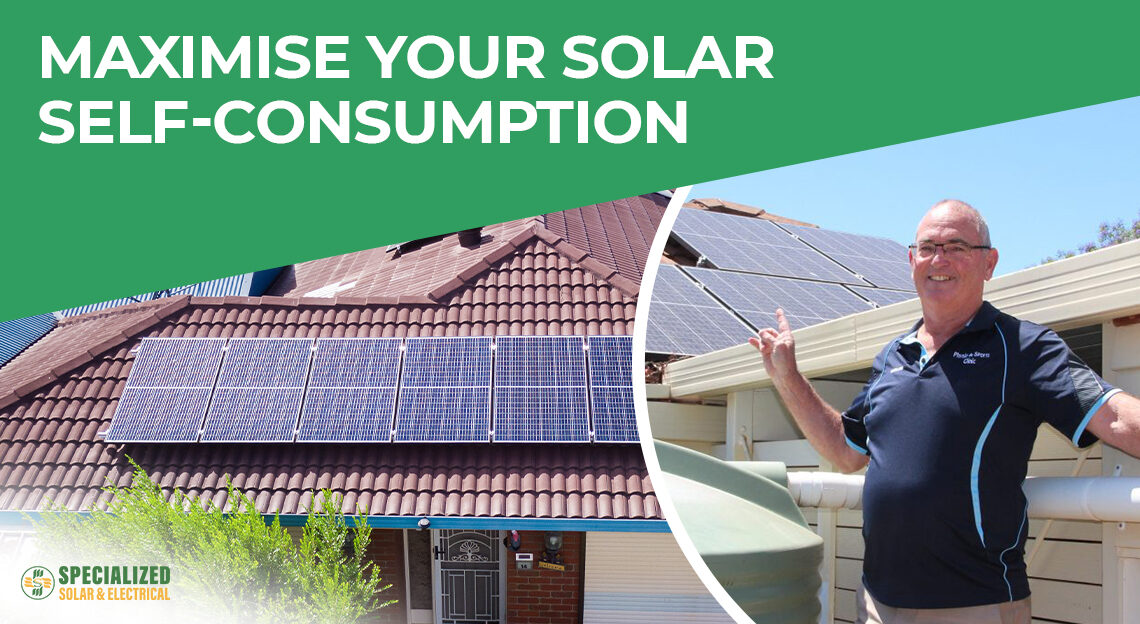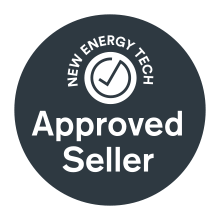You’ve got solar panels installed. Congratulations! Now you want low electricity bills. The best way to achieve this is by maximising your solar self-consumption.
Solar self-consumption sounds boring. But it’s the key to getting the most of out your solar.
Read this post to get the lowdown on solar self-consumption. It’s worth knowing about if zero-electricity bills are on your energy wish-list!
This blog will look at:
- What is solar self-consumption?
- Why maximise solar self-consumption?
- How can I tell what my solar self-consumption rate is?
- What solar self-consumption ratio should I aim for?
- How can I increase my solar self-consumption?
What is solar self-consumption?
Solar self-consumption means using the electricity generated by your solar panels to power your home, instead of sending it to the grid.
If you have solar panels, but no battery storage, maximising solar self-consumption entails using the electricity from your panels when it is being generated. In other words, matching generation with consumption.
If you have battery storage as well as solar panels, you have more options. If you can’t use all your solar power during the daytime, you can maximise solar consumption by storing it in your battery and using it at night to power your home.
This table shows what different solar self-consumption ratios mean in practice.
Solar self-consumption ratios: what they mean
| Solar self-consumption ratio | Amount of solar electricity used in your home | Amount of solar exported to the grid (assuming network approval) | Electricity bill savings. |
|---|---|---|---|
| 0% | 0% | 100% | Low |
| 50% | 50% | 50% | Good |
| 100% | 100% | 0% | Excellent |
Why maximise solar self-consumption?
The more you consume of your own solar electricity, the less you need to buy from the grid. This is the best way to reduce your electricity bills when you have solar.
Why is this the case?
It is because grid electricity is expensive, and the solar feed-in tariff is low.
Here are some numbers that will help explain:
- Most Australian homes pay around 25-30 cents per kilowatt hour for grid electricity.
- The Australian average feed-in credit is around 7 cents per kilowatt hour (although you may be able to get a bit more if you shop around).
- So, by exporting your solar electricity you’re only getting 7 cents per kilowatt hour for it. Whereas, if you use it in your home, you are saving around 25 or 30 cents per kilowatt hour as you don’t need to buy it from the grid.
- The difference is around 23 cents per kilowatt hour (kWh). That’s the net financial benefit of using your self-generated solar rather than exporting it!
Net benefit of using your solar electricity in your home
| What electricity costs to purchase from the grid. | What you get paid for exporting your surplus solar electricity. | Net benefit of using your solar electricity in your home to power your appliances. |
|---|---|---|
| 25-30 cents / kWh | 7 cents / kWh | 18-23 cents / kWh |
How can I tell what my solar self-consumption rate is?
Using the solar monitoring app that comes with your solar inverter is the best way to tell what your solar self-consumption ratio is.
Your app will show you the times of day when your solar system is generating the most power. Your goal is to use electricity at those times; in other words, matching solar generation with solar consumption.
Some of the better solar inverters such as SolarEdge also come with self-consumption monitoring. This gives you real-time information on how much of your self-generated solar electricity you are using in your home at any specific moment. If you are serious about maximising solar self-consumption, ask for consumption monitoring with your solar system.
If you have any questions about how to use your solar monitoring app, or if you don’t have one, get in touch.
What solar self-consumption ratio should I aim for?
We advise our customers to aim for a solar self-consumption ratio of at least 40 per cent. Then, by following the advice below, you should be able to increase your solar self-consumption rate to 60 per cent or better. With this self-consumption ratio, your electricity bill reduction will be substantial and you should be getting a payback on your solar panels system of 2-5 years.
If you decide to purchase battery storage, you should be able to get to 100 per cent solar self-consumption and be almost entirely grid independent. This will result in near zero electricity bills!
How can I increase my solar self-consumption?
1. Get a solar panels system that matches your energy usage
The first step is to install a solar panels system that’s orientated to maximise power production when you need it.
Whilst north-facing solar panels will generally produce more solar power, this may not get you the highest solar self-consumption rate.
That’s because you may not be home during the middle of the day when the solar is pumping out electricity. If that’s the case, an east-facing solar array combined with a west-facing array may give you a better result.
2. Know your electricity tariff
Check out your electricity tariff on your bill to see if you’re on a flat rate tariff or peak/off-peak.
If you are on a peak/off-peak tariff, you’ll want to use as little as possible grid electricity during the peak times – typically 3pm-9pm. However, this is also the time when you’re probably using more electricity, cooking dinner etc. It’s also the time when your solar panels will be generating less electricity. If this is the case, you may be better off switching to a flat rate tariff once you have solar installed.
On the other hand, if you are on a flat rate tariff your goal will be to maximise solar self-consumption, i.e. using your solar electricity when the panels are generating the most power. Flat rate tariffs are simpler to understand and generally preferred by households with a solar panels system.
Getting onto the best electricity tariff can be tricky. If you’d like advice and help modelling the savings with different tariffs, get in touch.
3. Know the best times to use electricity
By working through the above points, you will know the best times of day to use electricity to maximise solar self-consumption and avoid high electricity prices. This will be different for every household and depend on:
- orientation of your solar panels
- electricity usage profile: when and how much
- your electricity tariff
Once you’ve got this information, you’re in a great position to drive down your electricity bills by making the most of your solar energy.
4. Use timers
Use timers on appliances so they run when your solar system is producing energy. Even if you’re home during the day, it’s a habit worth getting into.
Appliances are getting smarter with apps that allow you to control them remotely. For example, some modern reverse cycle air conditioning systems have a feature allowing you to switch on your cooling when you’re at work during the daytime and return to a cool home that’s cost you nothing.
5. Switch off your aircon at night
On heatwave nights, having the aircon running through the night can make all the difference. But when the weather is milder, it’s worth putting your heating and cooling on a timer. That way you can go to sleep with the heating or cooling on, and it will automatically turn off in an hour or so when you’re fast asleep.
6. Insulate
Getting your home fully insulated is one of the most cost-effective ways you can improve the energy efficiency of your home. Heating and cooling can account for up to 50 per cent of your power bill. If you’ve got a home that’s well insulated, your home will be more comfortable and cost less to run.
7. Go all-electric
An all-electric home powered by solar energy is the best way to reduce your total power costs and get the fastest payback on your solar system. Choosing energy efficient electric appliances as old ones wear out makes sense. A gradual transition to all-electric is a sensible approach and will save you thousands of dollars in energy costs over the long run.
8. Install battery storage
With battery storage, your surplus solar electricity is stored for use when the sun isn’t shining. This means you can use your battery to power your home through the night, reducing your reliance on grid power. If the solar and battery system is sized correctly, this can result in 100 per cent energy self-sufficiency.
9. Purchase an electric car
With fuel costs skyrocketing, many people are thinking about making their next car an electric one. Several state governments – including NSW and Victoria – have put in place financial incentives to make electric cars more affordable. For solar households, having an electric car means you can charge it for free with the electricity generated by your solar panels. Talk to us if you’re interested in getting the right solar set-up for a future electric vehicle.
Get in touch
There are lots of ways you can maximise your solar self-consumption. As an accredited Clean Energy Solar Retailer and Registered Electrical Contractor, we have the in-house skills and expertise to help you with your transition to all-electric home powered by solar. Get in touch and we’ll be happy to help!












